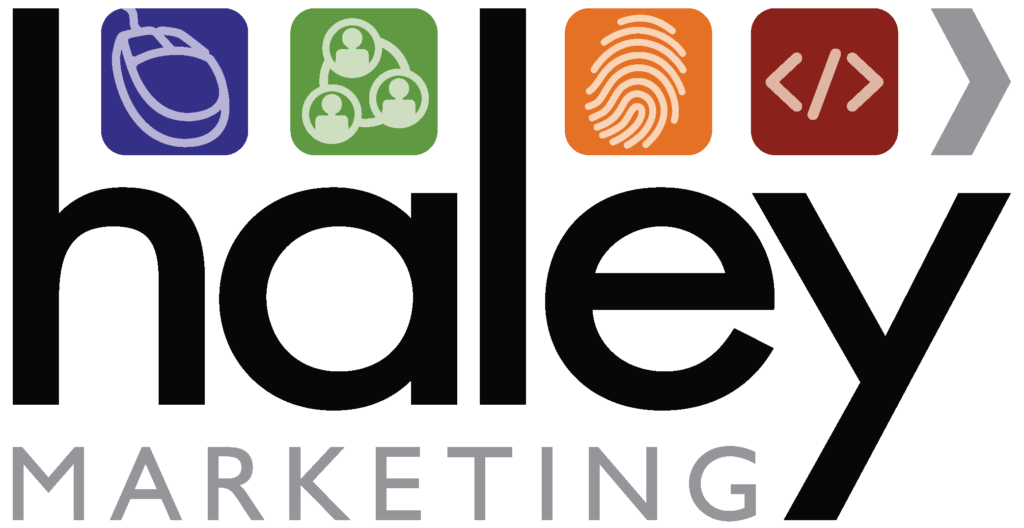“What’s in It for Me?”
Before reading the first line of this blog post, before clicking on the URL for this blog post, before logging on to your computer or unlocking your phone, that five-word phrase ran through your mind (consciously or subconsciously).
Why? Because our time is valuable.
With content overload, check out this amazing graph from Smart Insights, the competition to gain our attention isn’t diminishing anytime soon.
So, why did you click on this blog post?
The most obvious reason comes back to a thirst to learn and determine if there are any takeaways from a piece of content promising to be “The Ultimate Guide to Job Descriptions in 2019.”
And that’s my charge – to produce a guide for recruiters and staffing agencies to use this year to analyze their current job descriptions, make changes to those job descriptions and post the updated job descriptions with the goal of driving more candidate applications.
Makes perfect sense, right?
Stay with me for a second.
Flip Your Job Posts on Their Head
At the Haley Marketing Group, we work with more than 1,000 clients and hundreds of those clients have our proprietary job board software. Even if they don’t have our software, almost all of our clients post their jobs on their own website.
Whether it’s a project manager designing a new website or a social media marketing advisor running a staffing agency’s social media strategy, we see job descriptions all of the time.
And one common theme – the job descriptions follow the “What’s in It for Me” theme
BUT
the “What’s in It for Me” is for the hiring manager. It’s for your client. It’s for the recruiter.
It’s not for the most important person – the jobseeker!
The rest of this content will dig into more specifics and the tactical application of writing better job descriptions.
If there’s nothing else you take away from this article. If there’s nothing else you think about in 2019 (and beyond) when writing your next job description. If there’s nothing else you think about in your recruitment marketing for 2019. It’s this:
“What’s in It for Me”
For the job candidate… not anyone else!
What Do They Want to Read?
Salary. Don’t kid yourself. Don’t think otherwise. Salary.
LinkedIn conducted analysis to monitor jobseeker behavior when viewing a job posting. They used a “heat map” technology to track which part of the job description was highlighted the most.
Straight from the study: “The salary range and benefits were far and away the most highlighted portions of the job description”
The second part came in the form of a question: “Which parts of a job description were most important?”
- Compensation: 61 percent
- Qualifications: 49 percent
- Job Details: 49 percent
- Performance Goals: 33 percent
- Company Culture: 28 percent
- Company Mission: 27 percent
- Career Growth: 25 percent
Yes, this is a study about a business manager position in Manhattan, so it does focus on more of a white-collar position.
I don’t think we need to be very skeptical about industrial, clerical or other traditional staffing positions when it comes to jobseekers and salary. Some of them will jump to a different staffing agency and a new job for a fraction of a dollar more per hour.
Let’s take it the final step. Think about your own career. (Don’t worry, I’m not asking you to search for a job at work!)
If you are an active job seeker who is scanning job postings on job aggregators, social media or company websites, you look at salary. If you are a passive job seeker who comes across a job posting after a bad day at work or maybe have a conversation with someone in your network about a job. What’s one of your first questions?
What does it pay?
Why?
What’s in It for Me?
The first place that can be answered is in your paycheck, in your bank account, in your lifestyle.
Don’t make it too complicated. Think salary for your jobseeker’s sake.
And also for the sake of Google for Jobs.
Why Is Google for Jobs Important?
When Google for Jobs entered the game in 2017, it sent a pretty big signal that one of the biggest companies in the world saw an opportunity in the recruitment industry. By placing job listing results ABOVE traditional search results, that shows the importance Google is placing on its own Google for Jobs results.
Getting your jobs into the Google for Jobs listings requires the right bit of coding and sending other signals to Google. One of those signals is including the salary.
Why? Think about the very basic purpose behind Google search results.
When do we go to Google and type something into the search bar? When we need an answer to a question. It could be to find a restaurant, get the address of a destination or shop for shoes.
And what does Google do? It provides the best answer it can to your question or search query.
How does this relate to salary in job postings? Last year, a Google spokesperson mentioned one of the most requested data points from their Google for Jobs product was salary.
That takes us back to why Google for Jobs wants salary included in job postings – because it provides the best answer to the question of a job seeker who is looking for a new job.
“What’s in It for Me?”
That’s what Google things when the search algorithm tries to jump into the shoes of a user conducting a search. What does that user want to read?
If they are looking for a new job, they want to know about salary.
Include it in your job descriptions and increase your chances of having your jobs appear.
Building Off Compensation – Let’s Talk About Other Benefits
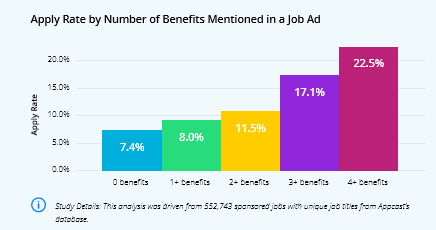 In June 2018, I attended a leadership summit in Minneapolis about programmatic ad buying. The presenting sponsor of the summit was Appcast – a leading developer in programmatic job advertising technology.
In June 2018, I attended a leadership summit in Minneapolis about programmatic ad buying. The presenting sponsor of the summit was Appcast – a leading developer in programmatic job advertising technology.
From their database of more than half a million job postings, Appcast puts together a Recruitment Media Benchmark Report that features trends in the industry. One of those trends comes in the listing of non-cash benefits. The data speaks for itself:
- 0 Benefits Listed – 7.4% application rate
- 1 Benefit Listed – 8% application rate
- 2 Benefits Listed – 11.5% application rate
- 3 Benefits Listed – 17.1% application rate
- 4 Benefits Listed – 22.5% application rate
You’ve taken the first step and listed salary in your job posting – which is great! Now, let’s take that next step. List other benefits. Think about medical insurance, travel perks, employee discounts and office benefits.
“What’s in It for Me” – which benefits are important to your jobseekers. Not to you and your company. The people who are actively or passively searching for a job.
Job Title – Don’t Make It Complicated
Now that I’ve hammered home the point about salary and benefits, let’s think about other aspects of the job description and start right at the top with the title.
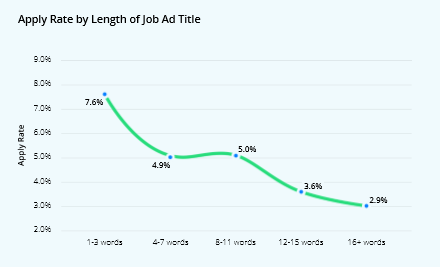
Experiment with different titles but don’t get caught up in creating unique and crazy job titles. (I have no idea what a ninja is, but I’m pretty sure they don’t work in your office.) That same Benchmark Report shows job ad titles with 1-3 words had a 7.6 percent apply rate vs. a 5.0 percent apply rate for 4-11 words.
From that same programmatic conference I referenced earlier, one of the early morning case studies came from KRT Marketing. The case study talked about Chipotle and how they used testing and experimentation to determine which job title to use when trying to hire for their open positions.
At Chipotle, the same person receives training to work at all of the stations (grill, cashier, prep, salsa, etc.) In such a versatile position, the challenge comes in “what the heck do you call job title?”
For example, they experimented with team member vs. cook (among other things). The end results were finding a job title that provided a 1 percent increase in conversion.
While that doesn’t sound like a big difference, the 1 percent increase led to a 17 percent decrease in cost per application!
“What’s in It for Me?” As humans, our attention spans are getting shorter and we need to grab attention quicker. If someone has to think about what the job could possibly be about, chances are they aren’t going to click on the job.
Think about the jobseeker when writing that job title and test out different options… just make sure they are short!
Job Description Length
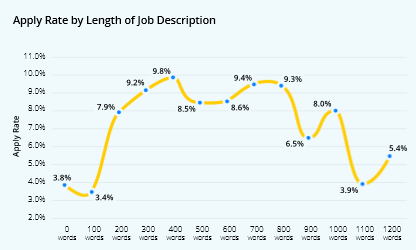 I promise this is the last time I reference the Benchmark Report, but I love data and it’s full of data.
I promise this is the last time I reference the Benchmark Report, but I love data and it’s full of data.
With your job description length, the results show job listings with 300-800 words performed best, posting an 8-9 percent application rate. You might be thinking less is more but under 200 words had an application rate under 4 percent. Over 1,000 words saw that same drop off to below 4 percent.
What’s in It for Me – If this job description features too much text and requires jobseekers to scroll for a long time when reading on their phone or when reading on their screen, they are going to be turned off and move to your competitor.
“What’s in It for Me” becomes not working for your staffing agency.
Now, the challenge, what do you actually say in the job posting?
What to Put in the Actual Posting?
A recent client call came with The Advance Group in talking about marketing and recruitment strategies for 2019. In talking with their leadership, they mentioned how their application rate has increased by double digits in the past couple of months?
Why? Because they changed their job descriptions.
Here’s exactly what I mean in two different postings:
Similar job titles. Similar jobs overall. But there’s a big difference in the first sentence of each of those job postings:
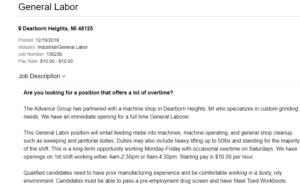 |
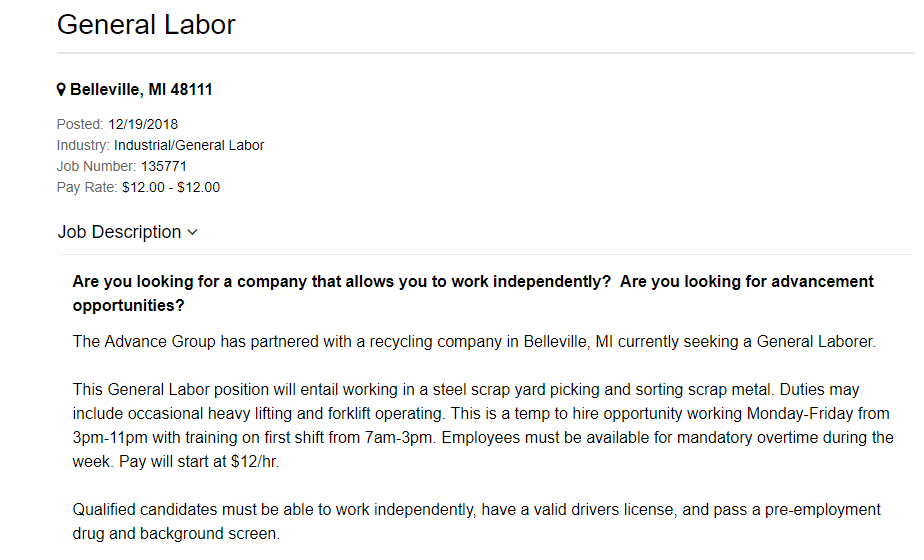 |
For two positions that are positioned as General Labor, they start off with an entirely different sentence. That is a perfect example of thinking about what the jobseeker wants.
Some jobseekers might want a job where they can work overtime and make extra cash because that’s a priority in their life. Some jobseekers might want to work for a company where they aren’t bother and can get on a career path that leads to a better job in the future.
Yes, it’s a small example, but it’s a perfect example.
“What’s in It for Me?”
The job isn’t talking about what the hiring manager wants in job candidates. It’s not talking about the day-to-day experience right off the bat. It’s not talking about that “We have a client who is looking for a temporary administrative assistant.”
It’s speaking to the needs and wants of the active job seeker. It’s speaking about salary. It’s speaking about career advancement. It’s quickly telling the jobseeker what this job and company offer, allowing the jobseeker to decide if this position is right for them.
Takeaways for 2019
It’s easy to get stuck in churning out the same job descriptions because recruiters are pressured with getting jobs posted as soon as possible. When a job comes from your client, it’s easy to just copy and paste (or make minimal adjustments) before getting on your website, a job aggregator or social media.
After reading this content, What’s in It for Me flips back over to you – the staffing agency owner, the recruiter, the HR director.
Here’s what to do:
- If you don’t have salary information in your job post, seriously consider posting that information in all of your future postings. It might require an internal discussion with leadership. It might require talking to your client. Bring them data. Show why salary information needs to be included
- What can you list for benefits for the jobseeker? What is important to them? What will make them apply for your job?
- Look at your job titles from the perspective of a jobseeker who knows nothing about the job. In those few words, is it getting them to just click on the job posting, let alone apply for it.
- Grab their attention right at the start of the job posting. We have short attention spans (some people say shorter than a goldfish.) Make it exciting for them. Make it interesting for the job candidate. Explain to them why they should apply for your job. How does it fit their values? How does it fit their desires? Why should they go through the painful process of switching jobs and undergoing all of those transaction costs?
Gather the data. Test. Optimize. Adjust. Repeat.
It’s a process that needs to stay agile and adjust to the latest trends. One formula could work for one set of your jobs and another formula could work for another set of your jobs.
Recruitment is hard. Better job descriptions make it easier.
Easier to recruit active candidates.
Easier to recruit passive candidates
Easier to beat your competition.
Remember, every time you produce a job description (and any piece of content for that matter:
“What’s in It for Me?”
Not you.
The candidate.
